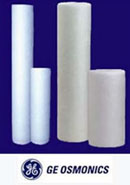About Water - Water Glossary
MANGANESE(Mg)- An element sometimes found dissolved in ground water, usually with dissolved iron but in lower concentrations. It causes black stains in laundry and plumbing fixtures at concentrations higher than 0.05 mg/l. It is remved the same way as iron, by ion-exchange or oxidation and filtration.
MEMBRANES- are thin films made with structures designed to provide selective transport of solutes. In general, the selectivity of a membrane is based on its ability to pass or exclude species according to their size. Membrane structures may be homogeneous or asymmetric. Homogeneous membranes have structures which are uniform in cross-section, at least to a magnification of 100x (Figure M.1a). Most homogeneous membranes have been developed for Microfiltration and hemodialysis.
MINERAL- A term applied to inorganic substances, such as rocks and similar matter found in the earth's strata, as opposed to organic substances such as plant and animal matter. Minerals normally have definite chemical composition and crystal structure. The term is also applied to matter derived from minerals, such as the inorganic ions found in water. The term has been incorrectly applied to ion exchangers, even though most of the modern materials are organic ion exchange resins.
MICRON- A liner measure equal to one millionth of a meter, or .00003937 inch. The symbol for the micron is the Greek letter "u". The smallest particle visible to the human eye is 40 microns. Most types of bacteria range from 0.05 to 10.0 microns in size.
NANOFILTRATION- A membrane process that treats water between reverse osmosis and ultrafiltration the filtration/separation spectrum. It can remove particles in the 300 to 1,000 molecular weight range such as humic acid and organic color found in water. Nanofiltration may be used for selective removal of hardness ions.
1 2 3 4 5 6 7 8

